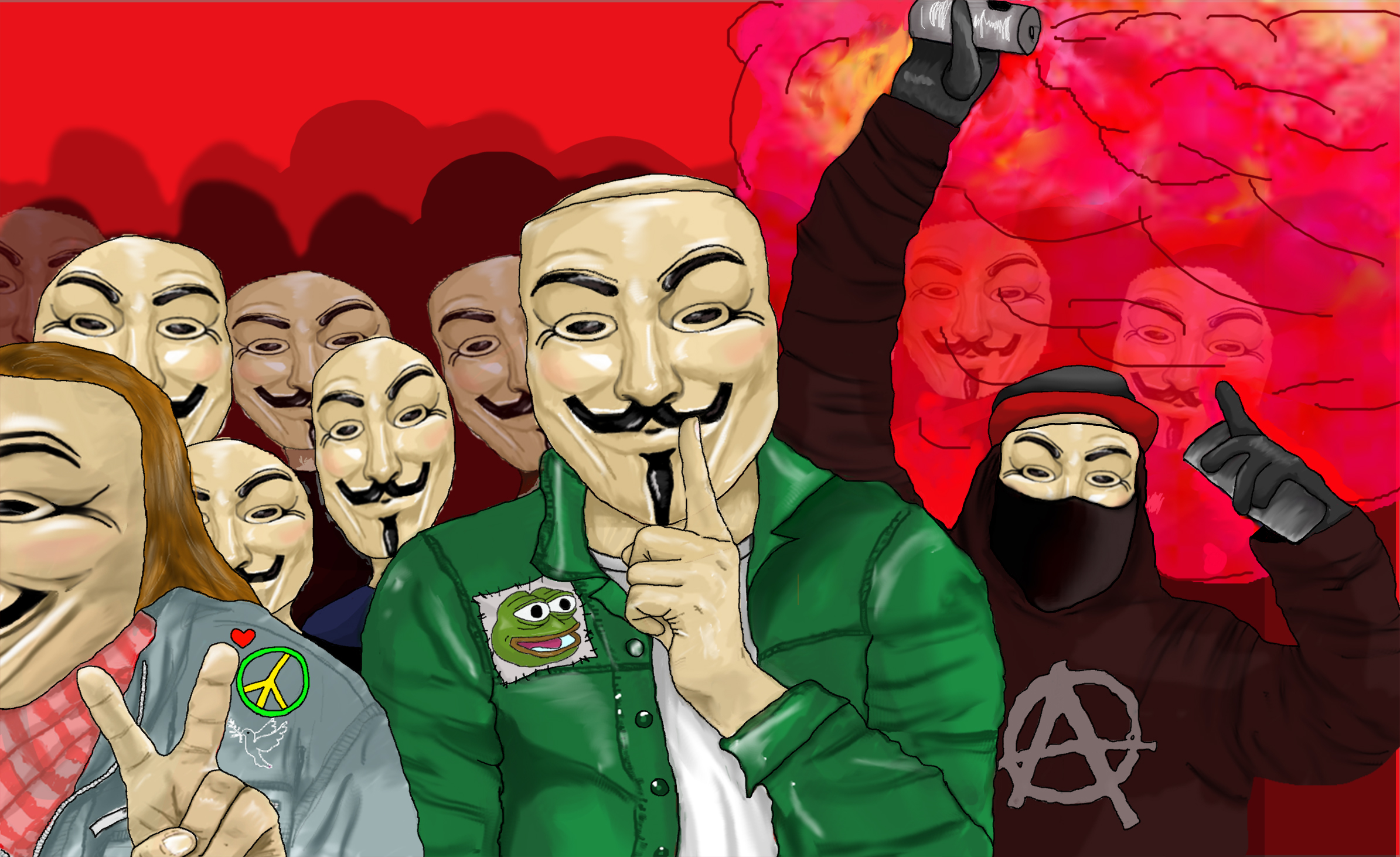On the evening of Saturday, November 5, roughly two hundred people gathered in Victoria Square for Montreal’s Million Mask March. Ostensibly organized by the decentralized global hacktivist group Anonymous, the annual march has taken place in cities around the world since 2013.
Its date coincides with Guy Fawkes Day, and protesters typically wear the stylized Guy Fawkes mask, which has become an emblem of Anonymous since the 2006 film V for Vendetta associated the mask with political protest in the public consciousness.
Gathered around a statue of Queen Victoria, the base of which had been covered in banners and placards for the occasion, those attending the protest chatted and chanted the occasional slogan. Half a dozen police officers watched from across a street, but did not intervene.
A wide array of political ideologies and causes were represented, with placards denouncing rape culture, the Dakota Access Pipeline, state surveillance, colonialism in Palestine, censorship, and capitalism, to name a few.
Many of the protestors who spoke to The Daily did not express affiliation with any specific political ideology, but rather expressed generalized frustration with aspects of society which they perceived as unjust or corrupt. Most protesters seemed to fall on the left of the political spectrum, though with varying degrees of radicalism and detailed analysis.
One demonstrator, however, declared support for the right-wing nationalist regime of Bashar al-Assad in Syria, and expressed profoundly anti-Semitic views in a brief interview with The Daily.
A wide array of political ideologies and causes were represented, with placards denouncing rape culture, the Dakota Access Pipeline, state surveillance, colonialism in Palestine, censorship, and capitalism, to name a few.
This disparity of beliefs and political orientations is seemingly a function of Anonymous’s decentralized structure – the hacktivist collective has no hierarchy of leadership and no well-defined ideology, beyond a broad opposition to censorship.
Individuals identifying with the group have launched cyberattacks against a slew of targets, from the governments of the United States and Israel, to Daesh (also known as ISIS), to video game companies, to financial corporations like Visa and MasterCard, to Quebec nationalism, to the Westboro Baptist Church.
Speaking to The Daily, a protester who identified himself only as Francis addressed the drawbacks of such a broad and decentralized movement.
“Some groups, probably on the right, could try and get a piece of the cake,” he admitted in French. “Obviously everyone knows who those people are, everyone knows they’re not legitimate, and they’re not the real ones – if I can say that. The real ones are always for rights, […] but it’s true that there are right-wing groups that often do really serious things under the mask of Anonymous. And obviously people who are in the know understand that it’s not us, the comrades, who do that.”
When asked what issues Anonymous addresses that are the most important to him personally, Francis, replied “human rights, […] the media that lies to us, […] the police services of many cities – especially Montreal – but especially poverty, in my opinion.”
What could Anonymous do to effect change on these issues, as opposed to legal action through mainstream political channels? According to Francis, the value of their work lies largely in raising awareness among the general population.
“The real ones are always for rights, […] but it’s true that there are right-wing groups that often do really serious things under the mask of Anonymous. And obviously people who are in the know understand that it’s not us, the comrades, who do that.”
“Raising awareness, and if ever there’s no visibility, doing concrete actions […] but it’s mostly informing people,” he said. “For example, if there was an organisation known for causing poverty, […] Anonymous might attack their servers, and crash their site, which […] would make people aware of the subject.”
The message of the Million Mask March, he said, was to tell the world “we’re here, we’ll always be here, and we don’t forget.”
The crowd gathered in Square Victoria, in addition to its diversity of political opinions and causes, comprised a variety of ages, ethnicities, and genders.
Speaking to The Daily, Flavie and Charlotte said they were frustrated by the prevailing climate of conservatism at their private high school, and had decided to attend the march out of a strong sense that Canadian society is profoundly flawed, and that “it’s not by doing nothing that these things will change.”
After some brief speeches, the protesters watched a video tribute to the late Jean Leger, a local anti-pipeline activist who recently committed suicide. Following this, they took to the streets, chanting various slogans from the classic – “Whose streets? Our streets!” – to the eclectic – “Killuminati!” and “Fuck the New World Order!”
The protest wound through the streets of the financial district, the lower Plateau, and Old Port, stopping at sites deemed emblematic of state violence and corruption: the Palais de Justice, the United States consulate, and the headquarters of the Service de Police de la Ville de Montréal (SPVM).
“Whose streets? Our streets!” – to the eclectic – “Killuminati!” and “Fuck the New World Order!”
Police officers on bicycles remained just ahead of the crowd, with several police vehicles following it, but no substantive confrontation occurred between protesters and law enforcement. The event ended peacefully outside the Palais de Justice, with organizers urging people to meet on November 5, 2017, for the next Million Mask March.
